
Sealing problems and piston ring damage
Dirt
Information on diagnostics
How does engine soiling develop? There are two principal causes of soiling of the engine compartment: dirt can enter into the engine compartment through a faulty air filter. Or the dirt may be in the oil circuit after a repair or reconditioning. This soiling may result in engine damage. Find out more here.
Intake of dirt in the engine is one of the most frequent reasons for early wear on the engine and, consequently, also on the piston rings. There are two principal causes of dirt damage:
Cause 1
Cause 2
The dirt is still in the oil circuit as a result of previous damage and/or a poorly carried out repair/reconditioning. The dirt then starts to wear on the cylinder walls and pistons from the crankcase. Dirt particles also reach all bearing positions in the engine via contaminated oil circuits. Although the oil is filtered via the oil filter, the oil circuit is frequently not cleaned correctly. Dirt that is already on the clean side of the oil circuit reaches the bearing positions and results in premature wear or damage.
 |
ATTENTION If an oil cooler is contaminated as a result of engine damage, cleaning often brings minimal success. In this case, it is better to use a new oil cooler to rule out the risk of damage resulting from using the old oil cooler. |
In the event of engine damage, the oil filter is often so heavily blocked through abrasion that the bypass valve opens. In this case, the engine oil reaches the lubricating points unfiltered. These facts are accepted in the engine design to prevent major engine damage due to complete oil loss on the bearings. Following engine damage, there are often still large amounts of dirt in the oil cooler and in its oil lines. It is therefore irresponsible to connect a new or reconditioned engine to an uncleaned oil cooler and run the engine.


